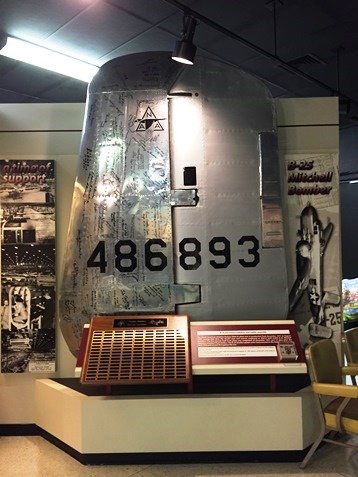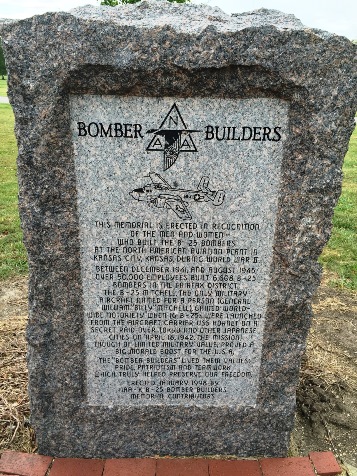
A World War II-era Kansas City, Kan., bomber factory that played a role in the advancement of women and minorities in the workplace will be the subject of a new exhibit at the Wyandotte County Museum, Bonner Springs.
The rededication of the B-25 Memorial at 11 a.m. Friday, Sept. 25, at the Wyandotte County Museum, near 126th and State Avenue, will open a new exhibit on the World War II-era airplane and the plant where it was built in Kansas City, Kan.
At the Friday event, there will be a proclamation and a wreath-laying to remember those who served at home and abroad, according to Trish Schurkamp, Wyandotte County Museum director.
It was about 75 years ago that the B-25 bomber plant began in the Fairfax area of Kansas City, Kan. It was Dec. 23, 1941, after the Dec. 6, 1941, bombing of Pearl Harbor and the entry of the United States into World War II, that the plant completed its first B-25.
Schurkamp said she hopes people who attend the ceremony Friday will pick up a sense of patriotism.
“I think that’s what the B-25 bomber builders would want you to walk away with, is the patriotism and what they felt for their country and for the men who were serving. There was a pride in who they were and what they did, and why they did it.”
The plant played a significant role in Kansas City, Kan., history, as well as the history of the nation, Schurkamp said. It was important for the war effort, and it brought about changes in the workplace of the time.
“I think the significance was the fact that women played such an important role because the men were serving, so the women went to work for the first time,” she said. “They were doing something to keep their men, husbands and fiances, safe. When the men came back, they went back into the home, but for that time period, they served.”
The women and men who worked in the plant were not serving their nation in a military uniform, but in a sense they were just as important, and serving in their own right, she believes.
“As a person who studies women’s history, I’m interested in that part of the story,” she said. “I think we’ve failed to remember the roles women have played, and it is one of those i- your-face moments when women were serving, and serving in their own right, to keep this country safe.”
The huge North American Aviation – Kansas plant was built in the Fairfax area. During the war time, from December 1941 to August 1945, it employed 59,337 people who built 6,608 B-25s. Later the building was converted into the first General Motors plant in Fairfax. It was torn down to make way for a parking lot and the second GM plant there..
Daniel Desko, a Kansas City, Kan., resident, designed the bomber builder monument at the Wyandotte County Museum.
His late grandfather, Harry Desko, one of the bomber builders, started the North American Aviation –Kansas Bomber Builders newsletter. His grandmother, Alice Desko, also worked at the B-25 plant. Daniel was involved, helping to type his grandfather’s newsletters, designing the pages, working on the computer to produce address labels, designing the monument and raising money.
“I’ve met hundreds of bomber builders,” Daniel Desko said. “You cannot have a conversation with a bomber builder without being in awe of them in general. They’re wonderful people, they’ve got a great outlook on life, they’re a great example for anyone today. If the world were more like the people back then, it would be a better place.
“Back then, these people did what they could for their country, they didn’t ask whether it was right, whether they should be doing it. It wasn’t all about them. It was about doing what they could for their country, a huge team effort,” he said.
“It was just a wonderful attitude,” he said. The B-25 factory workers were working 60 to 80 hours a week, for good money at the time, although by today’s standards it wasn’t considered much, he added.
“But they were doing it happily because they were serving their country,” Desko said.
About 40 percent of the plant’s workers in Kansas City, Kan., were women, and until then, the majority of women were not employed outside the home.
“It’s amazing to think what the women were going through with husbands, brothers and sons going to war,” he said. “They didn’t know if they were coming back, but they went to work everyday.”
“I definitely respect that, and definitely admire that, so that’s why last year I got back together with a group and started the B-25 history project, which picks up where my grandparents left off,” Desko said.
He also said there was no discrimination against minorities inside the plant, despite some common discriminatory attitudes in society at that time. The plant, with its 5 percent African-American employees at the end of the war, nearly reflected the minority demographics of the area at the time, which was about 6 percent, he said.
All the wartime plants around the nation had rules that women and minorities would be included in the workforce, and Desko said those ideals ushered in during wartime were later reflected in the presidential policies of Harry Truman and Dwight Eisenhower.
The B-25 plant also had an effect on the economy of Wyandotte County, he added.
“From economic standpoint the amount of money pumped into economy because of that one little plant, was amazing,” he said. “I don’t think Kansas City would be Kansas City without that plant.”
Other plants sprang up to become suppliers for the plant, he added. At one time, a shop class in a high school in Wyandotte County was involved in making wooden parts for the plane, he added.
Desko has started a website to bring the history of the B-25, along with the history of the men and women who built and flew them, to preserve it for future generations, he said.
There are original photos from that era, along with service pins from employees, letters from employees, information or newsletters from the plant, even a couple of formerly confidential folders about three B-25s after they crashed, he said. Only three out of those that were built suffered mechanical failures and crashed, he said.
Of the 6,680 B-25s made at the Fairfax plant, there are still some in existence, he said. He is working to create a biography of each one that still exists, and currently that is about 120. Thirty eight of the B-25 planes are actively flying now, and 37 of those were built at Fairfax, he added.
One of those B-25 planes will be coming into the New Century airport at Gardner, Kan., this weekend for an air show, he added.
He is planning to get a few bomber builders together to pose for a photograph at the B-25 plane this weekend with Lt. Col. Dick Cole, now 100 years old, who flew a mission in B-25s with Lt. Col. Jimmy Doolittle off the carrier Hornet, he added. The youngest of the bomber builders is now 89, he added.
“I’m lucky enough to meet some of the people who worked on the first B-25 at the Fairfax plant,” Desko said. He is telling their stories on his website at http://b-25history.org/index.htm.
“I told somebody the other day, when you are walking down the street, and see a vet sitting, I’ve seen a lot of people just walk over and shake their hands and thank them for their service,” he said. “It’s a great attitude.
“At the same time, the bomber builders did something just as important, we should walk up and shake their hand,” he said.


I would like to contact those involved in the history preservation of the B-25 story and the bomber builders. From what I have already researched, their’s is a story that should be taught in schools for young people to know their family contributions during the war years. My interest is in developing a story based on those “bomber builders” and the crews that depended on their dedication and production.
The story is needed. I would hope that something could be included about the building of the plant during the was years and the necessity of having to camouflage the large riff area so it could not be recognized as a plant from overhead.